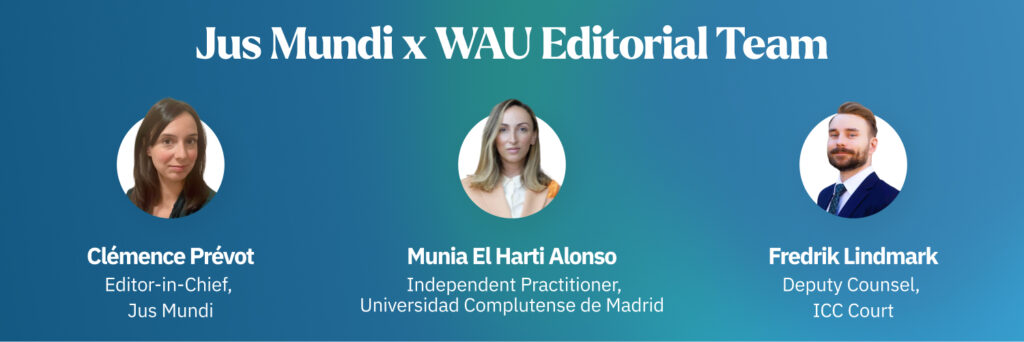World Arbitration Update 2024
THE AUTHOR:
Francesca Mastragostino, Junior Associate at Bonn, Steichen & Partners
THE EDITOR:
Munia El Harti Alonso, Independent Practitioner, Universidad Complutense de Madrid
The Fourth Edition of the World Arbitration Update (WAU) took place from 14 May to 23 May 2024. This post highlights the panel titled ‘What is the evolution of Third-Party Funding (“TPF”) in China in Litigation and Arbitration?’.
Jose Antonio Rivas SJD (co-founder of WAU/Xtrategy) opened the session by giving a brief background on TPF, emphasizing its novelty in investment arbitration and international commercial arbitration. He clarified that TPF has been in existence under different names and forms (such as institutional funders, law firm contingency fees, and personal loans from individuals like family members) and highlighted the need to demystify it: it is a straightforward concept where external funding is provided for legal proceedings in exchange for a share of the awarded damages. Focusing on China and its specificities, Mr. Rivas was joined by esteemed speakers who provided their insights and experiences on TPF in both arbitration and litigation contexts. Notably, WANG Heng (Global Law Office), LAU Chee Chong (Omni Bridgeway), LIANG Yu (HOUZHU Capital), WEN WEI Amy (CMS), HUANG Tao (King & Wood Mallesons), and YAO Yu (Hua Mao & Gui Gu Law Firm).
The Rise of Local Professional Funders in China
Mrs. Wang Heng discussed the rise of local professional funders in China since 2015. In doing so, she noted that while arbitration proceedings are confidential, TPF involvement becomes apparent when awards are subject to judicial review.
She cited cases where CIETAC awards involving TPF were reviewed, with courts affirming that Chinese law does not prohibit TPF in arbitration, reflecting a pro-arbitration stance by Chinese courts (such as Ruili Airlines Limited Company v Yunnan Jingcheng Group Limited and others, Jiangsu Province Wuxi Intermediate People’s Court, Case No. (2022) Su 02 Zhi Yi 14, or Ruili Airlines Limited Company v Yunnan Jingcheng Group Limited and others, Jiangsu Province Wuxi Intermediate People’s Court, Case No. (2022) Su 02 Zhi Yi 13). Differently, TPF in domestic litigation remains contentious, with contrasting court decisions in Shanghai regarding the legality of Litigation Funding Agreements (LFA), a point that other speakers will dwell on during the panel.
Mrs. Wang then highlighted divergent court rulings on TPF in litigation and arbitration. For instance, while in 2021, the Shanghai District Court upheld the legality of LFA in contract disputes (Winfirefly Information Technology (Shanghai) Co, Ltd v Changzhou Aino Textile Co, Ltd. (2021) Hu 0117 Min Chu No. 12,067), a 2022 Shanghai High Court ruling invalidated an LFA on public policy grounds, reflecting the contentious nature of TPF in domestic litigation (Company A v Company B, (2022) Hu 02 Min Zhong No. 10,224).
Mrs. Wang further commented on the introduction of TPF provisions in CIETAC and HKIAC arbitration rules for 2024, particularly article 48 of CIETAC rules mandating disclosure of TPF arrangements. He mentioned that other arbitration institutions in China are also recognizing TPF in their rules, indicating a proactive approach to this evolving practice.
Managing Risks for Clients
From the Funder’s perspective, Mr. Lau Chee Chong emphasized TPF’s role in managing risks for clients. He outlined the criteria for funding-merits, recoverability and economic viability, explaining how funders typically seek cases with a 70% chance of success and favorable economic outcomes. He also underscored the challenges of assessing a case’s success and the importance of recoverability, noting that funders often rely on third parties for asset tracing. Lastly, Mr. Lau shared insights on the growing interest in TPF among People Republic of China (“PRC”) companies, particularly for enforcing awards outside China.
Tips and Tricks to Tailor TPF Models to Clients’ Needs
Affirming that TPF is not a new phenomenon in China but has evolved, Mr. Liang Yu stressed the need to tailor TPF models to Chinese clients’ needs. He then commented on the asymmetries faced by Chinese companies in international disputes and underscored the value of TPF in bridging information gaps and providing expertise. In his opinion, TPF supports Chinese enterprises in international expansion by offering financial and strategic support, facilitating international legal agreements, and managing disputes effectively.
Furthermore, Mrs. Wen Wei Amy provided practical tips for clients considering TPF. She highlighted the risk-free liquidity advantage of TPF but pointed out the potential compromises on legal strategy and choice of counsel. Furthermore, she emphasized that TPF – even though it is less common – is also available for defendants. She further insisted on the importance of proportional dispute management and the need for clients to be prepared with comprehensive documentation for funders.
The Unique Challenges of TPF in China
Continuing the discussion, Mr. Huang Tao presented the unique challenges of TPF in China. Noting the prevalence of contingency fee structures and the public procurement process for legal services which limits funders’ influence, he also highlighted legal ambiguities surrounding LFAs and the difficulties in enforcing awards within China. Despite these challenges, Mr. Huang confirmed that TPF can be a welcomed solution, particularly in alleviating financial pressures and managing disputes effectively.
Mr. Yao Yu then underscored discrepancies in the judicial attitude towards TPF in arbitration and litigation, explaining that the pro-arbitration stance of Chinese courts supports TPF in arbitration, provided procedural rules are followed. However, LFAs in litigation face stricter scrutiny due to financial regulation concerns and potential conflicts of interest. In noting the differing judicial approaches to TPF in arbitration versus litigation, Mr. Yao suggested how the need for compliance with both financial and legal regulations could be an effective way of conciliating both worlds.
Lastly, Mrs. Wen Wei discussed the legal framework for TPF in Hong Kong, explaining that while maintenance and champerty doctrines restrict litigation funding, arbitration funding is embraced, particularly after the 2019 law reform. She detailed the disclosure obligations under Article 44 of the HKIAC rules and compared them with other international arbitration institutions’ approaches to TPF.
Conclusion
This panel was concluded by acknowledging both the complexities and potential of TPF in arbitration and litigation in China. TPF being relatively new an ever evolving in China, it is important to understand and decomplexify its regulatory landscape and framework in order to reinforce the growing use of TPF in both arbitration and litigation.
ABOUT THE AUTHOR
Francesca Mastragostino is a candidate to the Luxembourg Bar and Junior Associate in the Dispute Resolution Department at Bonn, Steichen & Partners in Luxembourg. She previously worked as a Legal Analyst at Qanlex, a litigation finance fund operating in Europe and Latin America, and holds an LL.M. in European and International Business Law.

*The views and opinions expressed by authors are theirs and do not necessarily reflect those of their organizations, employers, or Daily Jus, Jus Mundi, or Jus Connect.





